Mark Sisson's Blog, page 90
November 10, 2019
Heritage Turkey and Mashed Parsnips
 Thanksgiving is only a couple weeks away and in the United States this means one thing: turkey. Few other foods seem to dominate a holiday like this bird with a mind-boggling demand of 45+ million turkeys each Thanksgiving). Last week we offered a Primalized update—and upgrade—to the traditional pumpkin pie. This week we thought we’d whip up recipes for both the main event—the bird itself—and a lower carb alternative to its usual mashed potato pairing with a delicious and equally creamy accompaniment: mashed parsnips.
Thanksgiving is only a couple weeks away and in the United States this means one thing: turkey. Few other foods seem to dominate a holiday like this bird with a mind-boggling demand of 45+ million turkeys each Thanksgiving). Last week we offered a Primalized update—and upgrade—to the traditional pumpkin pie. This week we thought we’d whip up recipes for both the main event—the bird itself—and a lower carb alternative to its usual mashed potato pairing with a delicious and equally creamy accompaniment: mashed parsnips.
Beginning in the 1960s grocery stores started selling a breed of bigger, plumper turkeys known as Broad-Breasted Whites. This turkey is bred for one main reason: it’s cheap to raise, primarily because it’s genetically modified to grow quickly. Turkey producers can maximize their profits and provide what they think consumers want: birds with more white meat. But the thing is, all that white meat makes a turkey cook and taste different. In fact, it is probably Broad-Breasted Whites (not your mother’s cooking skills) that are to blame for decades of dry, flavorless Thanksgiving turkeys. Even worse than dry meat, the genetic modifications to Broad-Breasted Whites leave them unable to fly or reproduce without artificial insemination.
By far, the Broad-Breasted White is the dominant breed of turkey sold in grocery stores. In the 1990s, it almost put other breeds of turkey into extinction. Luckily, organizations and turkey producers dedicated to preserving culinary heritage and to fighting against industrialized food production have been diligently protecting natural breeds of turkeys that have been around since our forefathers. Collectively, these breeds of turkeys with colorful names like Bourbon Red, Standard Bronze and Narragansett are known as Heritage turkeys. In recent years, as consumers have become more interested in where and how their food is grown, Heritage turkeys are enjoying a surge in popularity.
Heritage turkeys are harder to find and more expensive to buy, ranging from $6.00-$12.00/pound, because they are more expensive to raise, taking up to 30 weeks to grow to close to 30 pounds, while a Broad-Breasted White can reach that weight in just 18 weeks. Why splurge on a Heritage turkey? Heritage turkeys have more fat and more dark meat, which helps keep the meat moist while cooking. The meat has a richer, heavier texture and more intense flavor, rich and robust and slightly game—what a “real” turkey is supposed to taste like.
Heritage turkeys can be bought from some local butchers and from Whole Foods Markets. Heritage Foods and Local Harvest ship directly to consumers, but their prices are higher than most retail stores. Buying a Heritage turkey is like casting a vote for humanely, naturally raised animals and for the farmers who are putting a premium on healthy, safe, natural food.
And, yes, a heritage breed turkey is ideal, but we’re never in favor of letting the perfect be the enemy of the good. (This is a holiday after all, and no one wants to disappoint Grandma by serving steak.) Other farms who aren’t necessarily raising heritage breeds are adhering to organic feed and humane-raised standards. Look for information on the turkey packaging and opt for the least/cleanest ingredients and best quality within your budget. If you have access to a local farm or farmers market, check with the farms to see what they have available…you may be surprised at how affordable some of them are!
Note: If you’re cooking a pastured/heritage breed turkey, they are leaner and will benefit from a lower cooking temperature like 325 degrees Fahrenheit, while you can get away with 350 or even 375 degrees with conventional turkeys.
Invest in a meat thermometer that has a steel probe so it is always keeping track of the internal temperature of the meat, even when you walk away.
The amount of ingredients for the herb butter may vary based on the size of your turkey. Feel free to scale the recipe up or down as needed.
Turkey carcasses make delicious stocks and soups! If you choose to make turkey stock or bone broth, pick off all meat from the turkey carcasses prior to making stock to prevent the meat from getting rubbery.
We use parsnips as a side, but you can also use other root vegetables or mix different root vegetables together. For variety, try turnips, rutabagas, celery root, potatoes or sweet potatoes!
Ingredients:
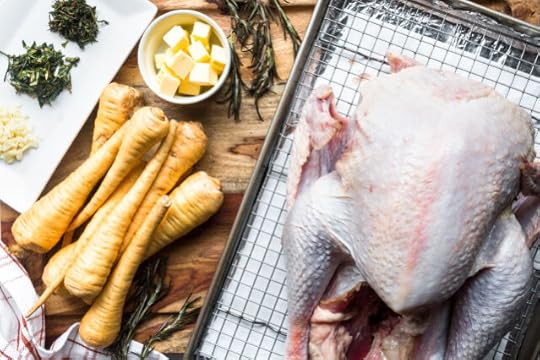
1 whole turkey, ours was around 12 lbs.
5 Tbsp. butter, melted
1.5 Tbsp. chopped rosemary
1.5 Tbsp. chopped thyme
6 cloves garlic, minced
1 tsp. salt
½ tsp. black pepper
4 lbs. parsnips
½ cup coconut milk (you can also use cream or your favorite milk substitute)
2 Tbsp. butter
salt and pepper, to taste
Instructions:
For the turkey: Remove any innards from the turkey and pat it dry on top of a roasting pan with a rack or a large sheet pan with a cooking rack. If you have time, you can dry brine the turkey by sprinkling the turkey skin all over with salt and pepper and allowing the turkey to rest in the pan uncovered overnight in the fridge. This will result in delicious, crispy skin later on. If you choose not to do this, continue right away to the next step.
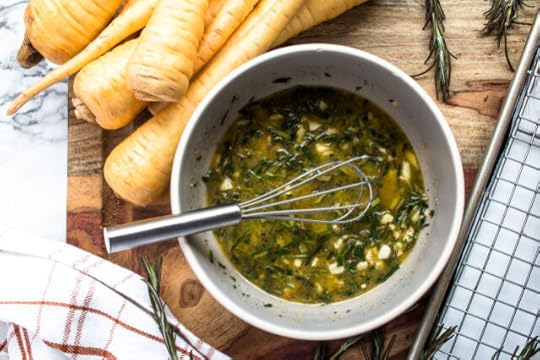
Preheat your oven to 325 degrees for pasture-raised/heritage breed birds and 350 for regular turkeys. In a bowl, whisk the butter, rosemary, thyme, garlic, salt and pepper together (if you did a dry brine with the salt and pepper already, omit the salt and pepper from the butter). Rub the herb butter all over the outside of the turkey. If you’d like, you can also add a couple pats of butter under the skin on the breasts of the turkey. If you are using a thermometer probe, place it in the thickest part of the breast and set the desired temperature for 165 degrees Fahrenheit.

Place the turkey in the oven on the lowest oven rack for about one hour, then check the skin. If the skin is beginning to brown too much, you can place a foil tent over the breasts but it shouldn’t be necessary. Pastured birds can take anywhere from 10-15 minutes per pound to cook, while regular turkeys can take 15-20 minutes. The best way to ensure the turkey is cooked properly is to use a meat thermometer. If you do not have a thermometer probe, check the internal temperature of the thickest part of the breast and thigh around the 1.5 hour mark and go from there.
Once the thermometer reaches the desired temperature, remove the turkey from the oven and tent it with foil. Allow it to rest for 15-20 minutes. Carve the turkey and pour any reserved juices on top.
For the parsnips: Peel the parsnips and cut them into rounds. Place them in a pot and fill with 3-4 cups of water, or just enough that the parsnip rounds are covered. Bring the water to a boil over medium heat and cover the pot. Reduce the heat slightly and allow the parsnips to simmer for around 10-15 minutes, or until just tender but not mushy.
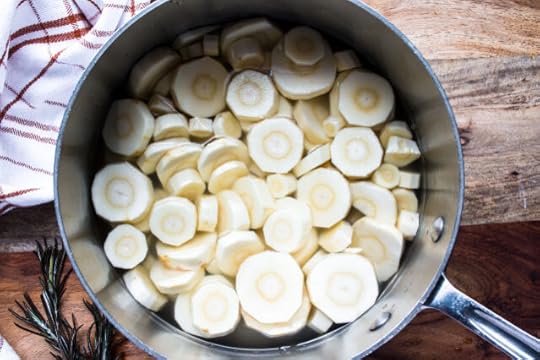
Drain the water and pour the parsnips in a food processor along with the coconut milk, butter, salt and pepper. Process until the parsnips reach your desired consistency. Alternatively, you can mash the parsnips using a potato masher. Top the parsnips with a pat of butter and a sprinkle of black pepper.

Nutritional Information
(Note: Turkey nutrition will vary based on size and dark or light meat. See below for nutrition info for 1/8 of the parsnip recipe):
Calories: 217
Total Carbs: 41 grams
Net Carbs: 30 grams
Fat: 6 grams
Protein: 3 grams
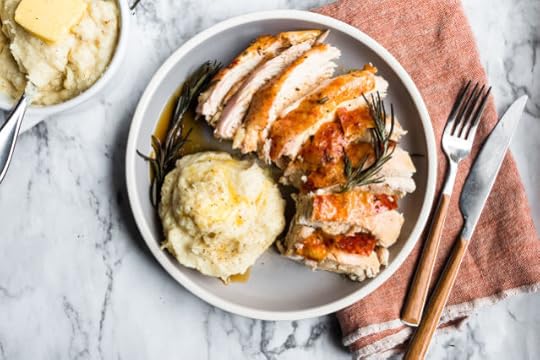

The post Heritage Turkey and Mashed Parsnips appeared first on Mark's Daily Apple.



November 8, 2019
Weekly Link Love — Episode 54

Research of the Week
Researchers discover the fossil of an 12 million year old arboreal ape who also did bipedal walking.
Human diseases may have wiped out the Neanderthals.
The flaws of food frequency questionnaires are fatal.
Whether you take it with or without MCT oil, coffee acutely reduces oxidative stress and increases ketone levels.
New Primal Blueprint Podcasts

Episode 387: Ali Miller: Host Elle Russ chats with “food as medicine” expert Ali Miller.

Episode 388: Chris Irvin: Host Brad Kearns chats with with keto supplement expert and Perfect Keto scientist Chris Irvin.

Primal Health Coach Radio, Episode 33: Laura and Erin chat with Samm Murphy about breaking through limiting beliefs.
Each week, select Mark’s Daily Apple blog posts are prepared as Primal Blueprint Podcasts. Need to catch up on reading, but don’t have the time? Prefer to listen to articles while on the go? Check out the new blog post podcasts below, and subscribe to the Primal Blueprint Podcast here so you never miss an episode.
Media, Schmedia
Good illustration of the disproportionate impact elite endurance training and coaching (as popularly practiced) can have on the health of young women.
Interesting Blog Posts
Blue space might be even better than green space.
Social Notes
Everything Else
Living off the land in an unlikely place: Orlando.
The best stuff lies along the margins.
China approves a new seaweed-based Alzheimer’s drug.
Things I’m Up to and Interested In
Podcast I’m loving: Healthy Rebellion Radio, the awesome, essential, and important new podcast by the inimitable and equally awesome, essential, and important Robb Wolf and Nicki Violetti.
Well deserved: Terry Wahls’ research team receives a $2 million gift.
This should prove useful: A new tool for studying the interaction between diet, lifestyle, exercise, and mitochondrial health and aging.
I haven’t seen it yet: Can you overdose on happiness?
I’ll probably have to write about this one: Higher fat intakes associated with higher HbA1c.
Question I’m Asking
What kind of roles did your parents play in your health?
Recipe Corner
Prosciutto is the best cured meat. Asparagus is one of the best vegetables. Why not combine them?
Most people don’t think about lamb when they consider Asian cooking, but this is great.
Time Capsule
One year ago (Nov 2– Nov 8)
Fasted Workouts: When They’re More Effective (and How I Incorporate Them) – All about fasted training.
7 Herbal Alternatives to HRT– Things to try.
Comment of the Week
“How to eat an egg properly:
https://www.youtube.com/watch?v=2eYYvWZST54
Start at about 16 seconds.”
– Glad to have you, Animanarchy.

The post Weekly Link Love — Episode 54 appeared first on Mark's Daily Apple.



November 7, 2019
Celery Root Soup
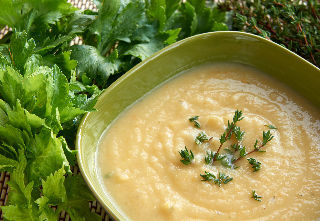 Beauty isn’t everything and celery root is living proof. There’s nothing about its knobby, gnarled, beige appearance that would entice you to put it in your shopping cart. You’ve probably passed by it a hundred times nestled between the turnips and rutabagas, not even realizing what an amazing root vegetable you’re missing in your life.
Beauty isn’t everything and celery root is living proof. There’s nothing about its knobby, gnarled, beige appearance that would entice you to put it in your shopping cart. You’ve probably passed by it a hundred times nestled between the turnips and rutabagas, not even realizing what an amazing root vegetable you’re missing in your life.
The flavor of celery root strongly resembles celery, but there’s also something potato-like about it in both taste and texture. It’s often eaten as a salad, grated then left raw or quickly blanched and mixed with mayonnaise, lemon and mustard. This time of year we prefer to cook celery root a little longer before serving. Peeled and cut into pieces, this vegetable can be braised, boiled, baked or sautéed. If you’re tired of using cauliflower as a mashed potato stand-in, give mashed celery root a try. Even better, gently simmer celery root, then puree it into a creamy soup.
Celery Root Soup is an incredibly easy recipe that can be doctored up into something a little fancier when you’re in the mood. The basic soup is simply shallots (or leeks) and regular celery sautéed in butter then simmered in broth or water with celery root for about 35 minutes. Puree the soup, then add whole cream (or coconut milk) to make the texture even silkier than it already is. Salt, pepper, add some chopped parsley and thyme, and you’re done.
Once you have this base, which is delicious as-is, the variations are endless. Add a little meat to the equation by frying bacon or pancetta in the pan with the shallot, or sprinkle crumbled bacon on top of the soup as a garnish when it’s done. Sauté mushrooms or spinach to add to the pot. Maybe grate a little Parmigiano-Reggiano cheese on top, or melt butter until it’s browned and has a sweet, nutty aroma and then drizzle it into your bowl.
You can make the soup with broth, bone broth or water. Water actually works quite well and lets the delicate flavor of the celery root shine through. Note: adding pureed celery root to other types of soup is a great way to make soup thick and creamy without adding dairy or potato.
So, next time you see this ugly but quite tasty vegetable at the store, go ahead and bring one home. It’s sometimes called celeriac, instead of celery root, and will most likely be displayed by the other root vegetables—not the celery. Celery root is a vegetable all on its own; it’s not actually the root of regular celery. The best way to attack celery root is with a paring knife, first cutting off the gnarled roots, then trimming off the skin.
Servings: 4
Prep Time: 15 minutes
Cook Time: 50 minutes
Ingredients:

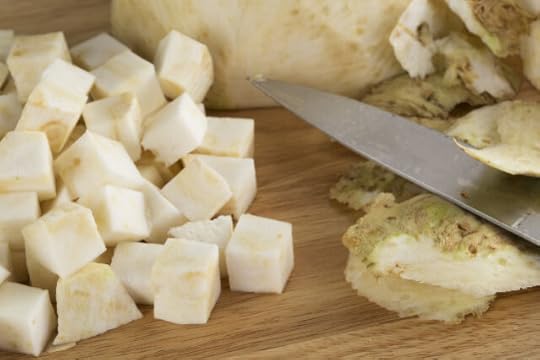
1/3 stick butter
4 celery stalks, chopped
1/4 cup finely chopped shallot (or 1 leek, sliced)
2 pounds celery root, (about two large roots) peeled and cut into 1/2-inch cubes
6 cups broth
1/3 cup heavy cream or coconut milk
salt and pepper to taste
1/4 cup finely chopped fresh parsley
1 teaspoon chopped thyme
Instructions:
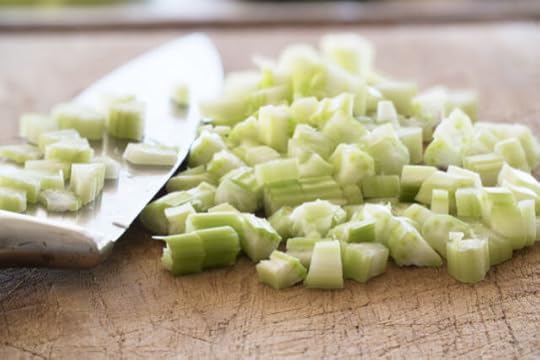
Over medium low heat, melt the butter in a deep pan. Add celery and shallot/leek and sauté until soft but not overly browned, about five minutes. Add celery root and sauté a few minutes more, then add 6 cups of broth or water and turn up heat slightly. Bring to a boil then turn the heat lower and simmer with a lid on for 35-40 minutes until the celery root is easily pierced with a fork.
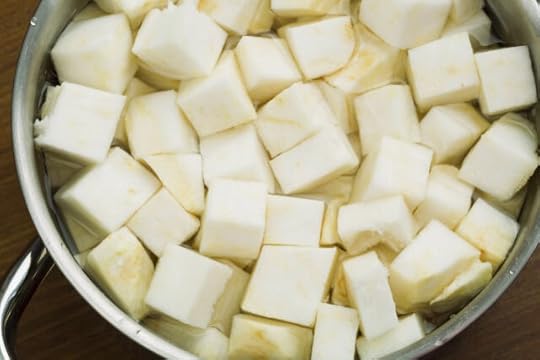
Working in small batches (to reduce the odds of splattering hot liquid on yourself and all over your kitchen) puree the soup in a blender until very smooth. If you prefer soup with more texture, only puree half of the celery root and leave the rest in chunks. Return the blended soup to the pot and slowly stir in cream or coconut milk. Use the remaining 2 cups of broth or water to thin out the soup to your desired consistency. Add salt and pepper to taste. Garnish with parsley and thyme.
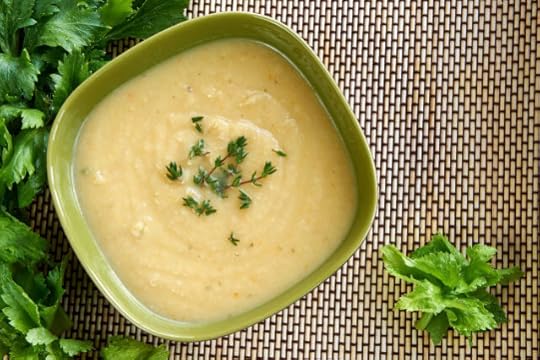
Nutritional Information (per serving with broth used):
Calories: 392
Total Carbs: 25.9 grams
Net Carbs: 20.7 grams
Fat: 27.65 grams
Protein: 12.72 grams


The post Celery Root Soup appeared first on Mark's Daily Apple.



November 6, 2019
The Definitive Guide to Inflammation
 Inflammation gets a bad rap in the alternative health world: “Inflammation causes heart disease, cancer, and autoimmune disease! It’s at the root of depression.” These are all true—to some extent.
Inflammation gets a bad rap in the alternative health world: “Inflammation causes heart disease, cancer, and autoimmune disease! It’s at the root of depression.” These are all true—to some extent.
Name a disease, and inflammation is involved.
Crohn’s disease is inflammatory.
Major depression is inflammatory.
Heart disease is inflammatory.
Autoimmune diseases, which involve an inflammatory response directed at your own tissues, are inflammatory.
Arthritis is inflammatory.
Even obesity is inflammatory, with fat cells literally secreting inflammatory cytokines.
Yes, but the story is more complicated than that. Inflammation, after all, is a natural process developed through millions of years of evolution. It can’t be wholly negative. Just like our bodies didn’t evolve to manufacture cholesterol to give us heart disease, inflammation isn’t there to give us degenerative diseases.
So, Why Does Inflammation Happen?
When pain, injury, or illness hit, the first responder is the acute inflammatory response. In other words, it is brief, lasting several days or less. All sorts of things can cause an acute inflammatory response. Here are a few:
Trauma (punch, kick, golf ball to the head)
Infection by pathogens (bacterial, viral)
Burn (sun, fire, seat belt buckle on a summer day)
Chemical irritants
Frostbite
Stabbing/Cut/Laceration
Allergic reaction
Things happen pretty fast in an acute inflammatory response and involve several different players, including the vascular system (veins, arteries, capillaries and such), the immune system, and the cells local to the injury.
First, something painful and unpleasant happens; choose one of the above injury options.
Then, pattern recognition receptors (PRR) located at the injury site initiate the release of various inflammatory mediators, which in turn initiate vasodilation (or widening of the blood vessels). This allows increased blood flow to the injury site, which warms the site, turns it the familiar red, and carries plasma and leukocytes to the site of the injured tissue.
The blood vessels become more permeable, thus allowing the plasma and leukocytes to flow through the vessel walls and into the injured tissue to do their work. Emigration of plasma into tissue also means fluid buildup, which means swelling.
At the same time, the body releases an inflammatory mediator called bradykinin, which increases pain sensitivity at the site and discourages usage of the injured area. These sensations—heat, redness, swelling, pain, and a loss of function—are annoying and familiar, but they’re absolutely necessary for proper healing.
Why Is (Acute) Inflammation Essential?
Allow me to explain why the four primary symptoms of acute inflammation are necessary, despite being unpleasant:
Increased blood flow warms the injury and turns it red, which can be irritating and unsightly, but it also carries the guys—leukocytes—that will be cleaning up the injury site, mopping up pathogens, and overseeing the inflammatory process.
Swollen body parts don’t fit into gloves, are really sensitive, and don’t work as well as their slim counterparts, but a swollen finger is a finger that’s full of a plasma and leukocyte slurry and therefore on the road to recovery.
Pain hurts, but if an injury doesn’t hurt and it’s serious, you’ll keep damaging it because you won’t know not to use it.
Loss of function prevents you from using what could be one of your favorite body parts, but you don’t want to make it worse be re-injuring it. Besides, it’s only temporary.
What About Chronic Inflammation?
These symptoms both indicate and enable inflammation (and, thus, healing), but what’s the deal with inflammation being linked with all those chronic illnesses—like obesity, heart disease, and depression? How does something normal and helpful go haywire and become implicated in some of the most crushing, tragic diseases of our time?
When inflammation becomes chronic and systemic, when it ceases to be an acute response, when it becomes a constant low-level feature of your physiology that’s always on and always engaged, the big problems arise.
The inflammatory response is supposed to be short and to the point. And because a big part of inflammation is breaking the tissue down, targeting damaged tissue and invading pathogens, before building it back up, the inflammatory response has the potential to damage the body. That’s why it’s normally a tightly regulated system: because we don’t want it getting out of hand and targeting healthy tissue. But if it’s on all the time—if chronic inflammation sets in—regulation becomes a lot harder.
Acute vs. Chronic Inflammation
A perfect example of the acute inflammation versus chronic inflammation dichotomy is exercise.
A single hard workout raises inflammation. It’s a stressor, a damaging event imposed upon your body. See for yourself.
A hard run spikes C-reactive protein for up to two days.
During exercise, skeletal muscle releases the inflammatory cytokine IL-6, a marker of damage.
Volleyball practice elicits spikes in IL-6 in both male and female elite volleyball players.
Acute exercise spiked CRP in cardiovascular disease patients (but a four-month exercise program lowered it).
This table of inflammatory responses to strenuous endurance events shows some massive spikes in CRP, some up to 20-fold the baseline value.
Yet, study after study (epidemiological and clinical alike) shows that extended exercise programs generally reduce markers of inflammation (like C-reactive protein) over the long-term:
In elderly Japanese women, a 12-week resistance training program reduced circulating levels of inflammatory markers compared to baseline; reductions in CRP were associated with increases in muscle thickness.
American adults who engaged in frequent physical activity tended to have lower CRPs than adults who were more sedentary.
In type 2 diabetics, (key term coming up) long-term high intensity resistance and aerobic training reduced inflammatory markers over the course of a year (independent of changes in body weight, meaning activity was the key factor).
Endurance combined with resistance training reduced CRP in young, healthy women better than endurance training alone.
In obese, post-menopausal women, a basic moderate cardio program lowered CRP without really affecting body weight either way over the course of a year.
There are many more out there, but the general gist is that regular exercise tends to lower markers of systemic inflammation while acute exercise increases markers of acute inflammation. And sometimes what’s acute can become chronic. How do we make sense of this? How do we avoid making those acute spikes a chronic, constant thing?
Identifying Chronic Inflammation: Objective Markers
First, we need to be able to identify chronic inflammation. What symptoms and biomarkers can we use to track our inflammation levels?
CRP, or C-Reactive Protein
CRP is a protein that binds with dead and dying cells and bacteria in order to clear them from the body. It can always be found (and measured) in the bloodstream, but levels spike when inflammation is at hand. During acute inflammation caused by infection, for example, CRP can spike by up to 50,000-fold. CRP spikes due to acute inflammation peak at around 48 hours and declines pretty quickly thereafter (post acute-phase inflammation CRP has a half life of 18 hours). Thus, if the incident causing the inflammation is resolved, CRP goes back to normal within a few days. If it persists, the infection/trauma/etc. probably persists as well.
Highly sensitive to many different kinds of stressors, CRP rises in response to essentially anything that causes inflammation. This makes it valuable for determining that inflammation is occurring, but it makes it difficult to determine why that inflammation is occurring—because it could be almost anything. But if you’re looking for confirmation that you are chronically, systemically inflamed, an elevated CRP (in absence of any acute infections, injuries, burns, or stressors) is a useful barometer.
“Normal” CRP levels are supposedly 10 mg/L. Absent infection or acute stressors, however, ideal CRP levels are well under 1 mg/L. You want to stay well below 1; you don’t want “normal.” Between 10-40 mg/L (and perhaps even 1-9 mg/L, too) indicates systemic inflammation (or pregnancy), while anything above that is associated with real acute stuff. Note that exercise can elevate CRP, so don’t get tested if you’ve worked out in the last couple days.
IL-6, or Interleukin-6
T cells (type of white blood cell that plays a huge role in the immune response) and macrophages (cells that engulf and digest—also known as phagocytosing—stray tissue and pathogens) both secrete IL-6 as part of the inflammatory response, so elevated IL-6 can indicate systemic inflammation.
Tissue Omega-3 Content
This is a direct measurement of the omega-3 content of your bodily tissue. It’s not widely available, but it is very useful. Remember that anti-inflammatory eicosanoids draw upon the omega-3 fats in your tissues and that inflammatory eicosanoids draw upon the omega-6 fats. People having a higher proportion of omega-6 fats will thus produce more inflammatory eicosanoids. Now, we absolutely need both inflammatory and anti-inflammatory eicosanoids for proper inflammatory responses, but people with high omega-6 tissue levels make way too many inflammatory eicosanoids. Studies indicate that people with the highest omega-3 tissue levels suffer fewer inflammatory diseases (like coronary heart disease).
Research (highlighted and explicated here by Chris Kresser) suggests that omega-3 tissue concentrations of around 60% are ideal, which is a level commonly seen in Japan—the seemingly paradoxical land of high blood pressure, heavy smoking, and low coronary heart disease rates.
Omega-3 Index
This measures the EPA and DHA, the two important omega-3 fatty acids, as a percentage of total fatty acids present in your red blood cells. It doesn’t correlate exactly to tissue amounts, but it’s pretty good and a powerful predictor of cardiovascular disease risk. The omega-3 index doesn’t measure omega-6 content, but those with a low omega-3 index are probably sporting excessive omega-6 in their red blood cells.
Anything above 8% corresponds to a “low risk,” but levels of 12-15% are ideal and roughly correspond to the 60% tissue content mentioned by Chris’ article. Four percent and below is higher risk and can be viewed as a proxy for increased inflammation (or at least the risk of harmful systemic inflammation developing from normal inflammation).
Heart Rate Variability
I’ve written extensively on HRV in the past. Long story short, high HRV predicts lower levels of inflammation.
Systemic Inflammatory Response Syndrome Score
There’s the systemic inflammatory response syndrome, which is incredibly serious and has four criteria. If you have two or more of them at once, congratulations: you qualify—and should probably see a health professional immediately. This isn’t relevant for low-grade systemic inflammation, like the kind associated with obesity or autoimmune disease.
Body temperature less than 96.8 F (36 C) or greater than 100.4 F (38 C).
Heart rate above 90 beats per minute.
High respiratory rate, 20 breaths per minute or higher.
White blood cell count fewer than 4000 cells/mm³ or greater than 12,000 cells/mm³.
Of these objective markers to test, I’d lean toward CRP, HRV, and one of the omega-3 tests. CRP is pretty comprehensive, HRV is a two-fer (inflammation and general stress/recovery), and, while omega-3 tissue or blood cell content doesn’t necessarily indicate the existence of systemic inflammation in your body, it does indicate the severity of the inflammatory response you can expect your body to have. Taken together, these tests will give you an idea of where you stand.
Identifying Inflammation: Subjective Markers
There are also subjective markers. They may be harmless artifacts, but they may indicate that something systemic is going on.
Flare-up of Autoimmune Conditions You Haven’t Heard From In Ages
Sore joints, dry, patchy, and/or red skin, and anything else that indicates a flare-up. For me, this is usually mild arthritis.
Water Retention
Acute inflammation is often characterized by swelling at the site of injury. The same effect seems to occur in states of systemic inflammation, although they aren’t localized, but rather generalized.
Stress Load
If you feel stressed, you’re probably inflamed. I’m talking about the kind that has you rubbing your temples, face palming, sighing every couple minutes, and pinching the space between your eyes very, very hard.
Persistent But Unexplained Nasal Congestion
Could be allergies, sure, but I’ve always noticed that when I’m under a lot of stress and generally in an inflamed state, my nose gets clogged. Certain foods will trigger this, too, and I think it can all be linked to a persistent but subtle state of inflammation.
Overtraining
If you fit the bill for the eight signs of overtraining listed in this post, you’re probably inflamed.
Ultimately, though? It comes down to the simple question you must ask yourself: How do you feel?
I mean, this seems like an obvious marker, but a lot of people ignore it in pursuit of numbers. If you feel run down, lethargic, unhappy, your workouts are suffering, you struggle to get out of bed, you’re putting on a little extra weight around the waist, sex isn’t as interesting, etc., etc., etc., you may be suffering from some manner of systemic, low-grade inflammation. Conversely, if you’re full of energy, generally pleased and/or content with life, killing it in the gym, bounding out of bed, lean as ever or on your way there, and your sex drive is powerful and age appropriate (or inappropriate), you’re probably not suffering from chronic inflammation.
Causes of Chronic Inflammation
We need to determine why inflammation is “on” all the time—and then take the steps to counter it. I’m going to fire off a few things that both induce inflammation and tend toward prevalence in developed countries. You let me know if anything sounds familiar to you.
Toxic diets: High-sugar, high-processed carb, high-industrial fat, high-gluten, high-CAFO meat, low-nutrient food is a pretty accurate descriptor of the modern Western diet.
Insufficient omega-3 intake: Omega-3 fats form the precursors for anti-inflammatory eicosanoids, which are an integral part of the inflammatory response. Poor omega-3 status means insufficient production of anti-inflammatory eicosanoids and a lopsided inflammatory response to normal stimuli.
Excessive omega-6 intake: Omega-6 fats form the precursors for inflammatory eicosanoids, which are an integral part of the inflammatory response. High omega-6 status (especially when combined with poor omega-3 status) means excessive production of inflammatory eicosanoids and a lopsided inflammatory response to normal stimuli. The more omega-6 you eat, the more omega-3 you crowd out for anti-inflammatory eicasonoid formation.
Lack of sleep: Poor sleep is linked to elevated inflammatory markers. Poor sleep is a chronic problem in developed nations. Either we go to bed too late, wake up too early, or we use too many electronics late at night and disrupt the quality of what little sleep we get. Or all three at once.
Lack of movement: People lead sedentary lives, by and large, and a lack of activity is strongly linked to systemic, low-grade inflammation. People don’t have to walk to get places, they take escalators and elevators, they sit for hours on end, and they don’t have time for regular exercise.
Poor recovery: Other people move too much, with too little rest and recovery. When I ran 100+ miles a week, I certainly wasn’t sedentary, but I was chronically inflamed. Overtraining is a form of chronic inflammation.
Chronic stress: Modern life is stressful. Bills, work, commuting, politics, exercise that you hate – it all adds up and it doesn’t seem to let up or go away. And if it becomes too much for you to handle (I know it’s too much for me at times), your body will have a physiological, inflammatory response to emotional stress.
Lack of down time: When you’re always on the computer, always checking your email/Facebook/smartphone, you are always “on.” You may think you’re relaxing because your body is stationary, but you’re not relaxing.
Lack of nature time: We spend too much time contained in cubicles, cars, trains, and cities, away from trees, leaves, and soft earth. In a way, nature is home for us. Going home certainly has its measured benefits.
Poor gut health: The gut houses the bulk of the human immune system. When it’s unhealthy, so is your inflammatory regulation. A healthy gut is also selectively permeable, allowing beneficial compounds passage into the body and keeping toxins out. An unhealthy gut often becomes leaky, allowing toxins into the body to stimulate an immune, inflammatory response.
Poor acute stressor/chronic stress ratio: We respond far better to acute stressors than repeated, sustained stress – even if the latter is of a lower intensity.
See what I mean? Since we’re set up for acute stressors requiring an acute inflammatory response, all this other low-level, evolutionarily-discordant, superficially mild stuff set against a backdrop of misaligned fatty acid ratios and impaired gut health throws us off and sets us up for a lifetime of chronic inflammation.
Inflammation is a complex physiological process that can go wrong in a lot of ways. But luckily, sticking to the tried and true dietary and lifestyle measures will get you most of the way toward preventing inflammation from becoming chronic and untamed.
If you have any further questions about inflammation, fire away down below! Thanks for reading.

References:
Eliakim A, Portal S, Zadik Z, et al. The effect of a volleyball practice on anabolic hormones and inflammatory markers in elite male and female adolescent players. J Strength Cond Res. 2009;23(5):1553-9.
Lara fernandes J, Serrano CV, Toledo F, et al. Acute and chronic effects of exercise on inflammatory markers and B-type natriuretic peptide in patients with coronary artery disease. Clin Res Cardiol. 2011;100(1):77-84.
Ford ES. Does exercise reduce inflammation? Physical activity and C-reactive protein among U.S. adults. Epidemiology. 2002;13(5):561-8.
Balducci S, Zanuso S, Nicolucci A, et al. Anti-inflammatory effect of exercise training in subjects with type 2 diabetes and the metabolic syndrome is dependent on exercise modalities and independent of weight loss. Nutr Metab Cardiovasc Dis. 2010;20(8):608-17.
Daray LA, Henagan TM, Zanovec M, et al. Endurance and resistance training lowers C-reactive protein in young, healthy females. Appl Physiol Nutr Metab. 2011;36(5):660-70.
The post The Definitive Guide to Inflammation appeared first on Mark's Daily Apple.



November 5, 2019
Tracking Your Food: When, Why and How
 There was a time when food tracking was treated like a given, a necessary tool for anyone wanting to lose weight or better their health. Thankfully, there’s more nuance to that conversation now. The fact is, tracking your food can be a useful exercise for gaining more insight into what you’re putting in your body. It can also be a tedious endeavor that sucks all the joy out of eating.
There was a time when food tracking was treated like a given, a necessary tool for anyone wanting to lose weight or better their health. Thankfully, there’s more nuance to that conversation now. The fact is, tracking your food can be a useful exercise for gaining more insight into what you’re putting in your body. It can also be a tedious endeavor that sucks all the joy out of eating.
If you’re going to invest the time—and it can be quite time-consuming if you include any variety in your diet—let’s make sure it’s not a waste.
You Might Want to Track Your Food If…
You have a goal where hitting a specific macronutrient and/or caloric intake is important. This includes cutting before a bodybuilding competition, starting a ketogenic diet, or even just losing weight.
You’re conducting an experiment. Maybe you want to see how your hunger changes when you eat more protein and less fat, or if your sleep improves if you increase your total carbs by a certain amount. Maybe you’re going to try a month of strict carnivore and plan to track your micronutrient intake.
You suspect you aren’t eating the right amount. If weight loss has stalled, your total calorie intake might be higher than intended. On the flip side, if you’re an athlete whose performance and recovery have been subpar lately, perhaps you are eating too little. Some people find that keto dramatically suppresses their appetites to the point where they need to intentionally eat more. In any case, you can’t make the necessary adjustments unless you know how much you consume on a typical day.
You Don’t Need to Track Your Food If…
You feel good and aren’t looking to change anything. If it ain’t broke, don’t fix it.
You stick to the same basic meals most of the time. Even if you’re trying to manage your macros, if you’re a creature of habit, you can probably get away without tracking. Once you know the nutritional info for your standard meals, there’s no reason to input them in a food tracker over and over.
You’ve been keto for a while. You have a good sense of how to keep your carbs low enough to stay in ketosis, and/or being in ketosis 24/7 isn’t that important to you.
You just don’t want to. Your desire to eat intuitively outweighs your desire to manage your food intake.
You SHOULDN’T Track Your Food If…
It triggers unhealthy eating behaviors or anxiety, or it otherwise messes with your mental and emotional well-being.
Is Food Tracking Reliable?
There will always be some error in food tracking. Besides measurement error on your end (we’ll get to that in a minute), there is natural variation in foods. One ribeye is fattier than the next. This apple contains more water. That cabbage was grown in more nutrient-depleted soil.
The FDA allows for up to 20% error on packaged food labels. That means that any information you get off the package might be wrong by 20% in either direction. Likewise, if you’re eating in restaurants and relying on the nutritional info they provide, consider it a rough estimate. Depending on how the food is prepared and the portion size you are given, your specific meal might vary a little or a lot.
All this is to say that food tracking is not an exact science. That doesn’t mean it’s futile—it can still be useful for the reasons I gave above. However, there’s no point in stressing if you’re off your daily targets by 25 calories or 7 grams of fat. You should view tracking as a helpful but imprecise method of gathering data. Don’t micromanage to the point of causing yourself grief or anxiety.
How to Track for Maximum Accuracy
That said, there are steps you can take to improve the accuracy of your tracking:
Weigh, Don’t Measure
If you care about precision, invest in a food scale. While tablespoons (mL) work for liquid measurements like salad dressing, weight is much more accurate for proteins, fruits and veggies, nuts and seeds, and legumes.
Weigh Foods Raw
This is true even if you intend to cook them. When you enter them in your food tracker, make sure you select the entries for the raw items (e.g., “Celery, raw” instead of “Celery, cooked”).
Do NOT Use Pre-entered Recipes
For example, if you make a pot of chili, do not simply select the entry for “Chili” in your food tracking app. Your version of chili might differ substantially from what’s considered “average” chili by the app.
Most tracking apps will allow you to input custom recipes, which is helpful for foods you will make again and again. Alternately, you can enter the ingredients separately into your daily food log.
If you are cooking big batches of multi-ingredient recipes, the best way to figure out exactly how much you ate is to weigh the final product and then weigh your portion. In the chili example, you’d create a custom chili recipe in your app and enter all the raw ingredients. After it’s cooked, weigh the entire batch, then weigh your portion. If you make 800 grams of chili and eat 150 grams, you ate 18.75% of the recipe.
If this sounds like a lot of work, you’re right. Food tracking is so much easier if you prepare simple meals: protein, side of vegetables, add healthy fat. It can be a major bummer for those of us who like to experiment in the kitchen and prepare more elaborate meals.
Tracking FAQs
What’s the Best App?
There are lots of options here. I personally like and recommend Cronometer. The free app and desktop version have everything you need, but there is also an inexpensive premium version. The entries are all based on official food databases, so it’s as accurate as you can get, and it provides pretty granular nutritional info. You can input your own macronutrient targets and also add custom recipes.
Primal folks might also prefer Cronometer because, unlike a lot of food tracking apps, it doesn’t assume you are trying to be keto or even low carb. If you are keto, Carb Manager and KetoDiet App are two popular options. Personally, I don’t like that Carb Manager grades foods based on what it considers acceptable for keto. My beloved Japanese sweet potato gets an F—no thanks (even if I can’t eat a big portion on keto). I’ve never tried KetoDiet App because it costs $8.99, whereas Cronometer is free and gives me everything I need. If you have tried it, let us know what you think about it in the comments below.
Whatever app you choose, don’t assume that the default macro settings are right for you. A lot of keto apps will set your carb limit at 20 to 25 grams, for example, whereas The Keto Reset Diet recommends starting with 50 grams total. (This usually works out to 30 to 35 grams net in my experience.) The calories might not be appropriate for your activity level. Either set custom macros or simply ignore the app when it says you are over your carb limit or calories or whatever.
How Do I Track Cooking Fat?
It’s impossible to know how much fat you leave in the pan when you sauté your veggies or how much oil is absorbed you fry chicken. Since most people are more concerned with eating too many calories than too few, the more conservative approach is to add all the cooking fat to your food diary when sautéing or roasting (i.e., assume you consume it all). When frying, the best answer is to weigh your cooking oil before and after frying to estimate how much is absorbed. Neither will be precise, but it’s the best you can do, so don’t stress about it.
Is There a Preferred Time/Method For Tracking?
How and when you track your food depends on why you’re tracking in the first place. If you’re trying to get an unbiased look at how you’re currently eating, I recommend logging your food on paper for a few days, then entering it into an app to get the nutritional info. Logging makes us more mindful of what we are eating. This is generally a good thing, but if you’re trying to get an accurate snapshot, you don’t want to change how you’re eating based on the data.
If you’re trying to manage what you eat, it’s best to enter your food before you eat it. This keeps you from accidentally eating more or less than you want, and it helps you balance your macros according to your goals.
Whatever you do, log foods as you weigh/measure/eat them. Don’t think you’ll remember exactly what you ate earlier today, much less yesterday or the day before. You won’t.
Do I Have To Track My Food If I’m Keto?
You never have to track your food. However, if you’re serious about being in ketosis, I do recommend tracking your food for at least a week or two at the beginning just to make sure you’re on track. Most people don’t know how many carbs are in foods, so it can be easy to go over your limit. Managing your electrolytes is also very important. Apps like Cronometer will show you how much sodium, potassium, and magnesium you are getting from food so you can supplement appropriately.
Can I Just “Lazy Track”?
Sure, you can eyeball portion sizes of steak and measure your broccoli in a measuring cup instead of buying a food scale. It won’t be particularly accurate. As long as you understand that, go ahead. I wouldn’t bother taking the time to track for this level of (im)precision though.
Thanks for reading today, everybody. If you track your food, what insights or benefits have you gotten? What app do you prefer and why? Let us know below.

The post Tracking Your Food: When, Why and How appeared first on Mark's Daily Apple.



November 4, 2019
The Primal Blueprint Revealed a Potential I Didn’t Know I Had
It’s Monday, everyone! And that means another Primal Blueprint Real Life Story from a Mark’s Daily Apple reader. If you have your own success story and would like to share it with me and the Mark’s Daily Apple community please contact me here. I’ll continue to publish these each Monday as long as they keep coming in. Thank you for reading!

Yup, success stories are back! And I’m looking for more. Follow-ups, mid-progress reflections—every story at every stage has the potential to inspire folks out there who are getting started or contemplating a new beginning. Contact me here to share your story—long or not so long. You never know who you’ll impact by doing it. Enjoy, everyone!
The Primal Blueprint revealed a potential I didn’t know I had. I was never an athlete. Fitness has always been a struggle. But underneath that was a potential I didn’t know I had. At 39-years-old I now look, move and feel better than I did at 19. And I’ve begun engaging in adventures that my younger self couldn’t dream of. Here’s how it happened.
The process started in 2012. I was taking acid reflux medication and needed to lose weight. Already at 32 I felt old. I started doing calisthenics at home and took a long hard look at my diet. I tried everything. I even dabbled with a mostly plant-based diet. The sheer volume of nutrition, fitness and training advice caused me to jump around. Eventually I started drawing towards aspects of Paleo. In particular I starting eliminating highly processed carbs and fats. It was a struggle, but I started getting results.
2016 was the pivotal year. In February, a friend at work approached. “I just heard a guy named Mark Sisson on Joe Rogan. It was really interesting. You’d like it.” After listening to the interview, I immediately read Primal Endurance, and then Mark’s other books. I dove into Mark’s Daily Apple.
The timing was perfect. My wife was due with our first child. That meant a family would be coming soon. And it had me freaking out. Playing like a kid with my kids in my forties would be a challenge, but it had to happen. I wouldn’t be the broken down old man with young kids. I was motivated to make big changes.
I focused on eating plants and animals, and the diet just clicked. I reorganized my training to make it more Primal. I focused on moving frequently at a slow pace. And I started sprinting. I also started noticing how lifestyle factors affected my health and recovery.
It’s hard to give an accurate picture of the process. It wasn’t uninterrupted success. There were many setbacks. There were lessons I had to learn and re-learn. But in the end, I earned a six-pack for the first time in my adult life. With my increased recovery and my focus on sensible, sustainable training, I made serious progress. I built muscle, leaned out and starting moving better than ever.
As I got more comfortable with the diet and lifestyle I began adding new skills. I started skipping breakfast and spent the winter in Keto. I even bought a pair of Vibrams.
Primal also got me to rethink my potential. Looking at our ancestral heritage, I thought, why couldn’t I have a body built for high adventure? Isn’t it our genetic birthright? The idea fascinated me. I had always loved travel and adventure, and when I was younger, I had engaged in both.
In 2017, I decided to go all in. I became a Primal Health Coach. The education gave the Primal Blueprint’s organizing principles new depth. Plus the education, including the business modules, inspired me to keep pushing my limits.
In 2015 I had read about MovNat, in the book Natural Born Heroes. At the time, I thought younger, fitter people might enjoy the training, but I never entertained the thought of trying it myself. Primal changed that. In 2018 I started training MovNat, and at 38-years-old I became a MovNat Master Trainer. I could not have dreamed of participating in such intense, difficult training before I discovered Primal.
Things that seemed physically impossible in my twenties will be very doable in my forties. I anticipate playing like a kid with my grandkids. And I’ve started a coaching business to help others achieve similar results. Because of Primal I’ve started a new chapter of life that I couldn’t have imagined when I first listened to Mark. Thanks.
—Chris Redig
You can connect with Chris at Adventure Driven Fitness or Instagram.
Also, check out his past guest post on MDA here.


The post The Primal Blueprint Revealed a Potential I Didn’t Know I Had appeared first on Mark's Daily Apple.



November 3, 2019
Ultimate Primal Pumpkin Pie
 Traditions are a big part of the holiday season for many people, but if you find yourself doing something strictly out of tradition and not because you particularly enjoy it, then it’s time for a new tradition. Or maybe, just time for a new recipe. Take pumpkin pie. It’s hard to imagine Thanksgiving without one, but too often it’s a soggy, bland dessert that disappoints. Made with a cup of sugar and white flour crust, it’s an indulgence that’s not always worth it.
Traditions are a big part of the holiday season for many people, but if you find yourself doing something strictly out of tradition and not because you particularly enjoy it, then it’s time for a new tradition. Or maybe, just time for a new recipe. Take pumpkin pie. It’s hard to imagine Thanksgiving without one, but too often it’s a soggy, bland dessert that disappoints. Made with a cup of sugar and white flour crust, it’s an indulgence that’s not always worth it.
But what if you broke from the traditional recipe by taking the granulated sugar and flour out—and it actually made the pie taste better? What if this new and slightly untraditional version of pumpkin pie had a buttery, crunchy crust and silky-smooth filling? Sure, you could call this new and improved version Primal Pumpkin Pie. Or, you could just call it by another name: Damn Good Pie.
The best place to start the re-invention of pumpkin, or really any pie you’re serving, is with the crust. Nut-based crusts don’t have the exact same flavor or texture as a crust that you roll out from a flour-based dough. However, the buttery-crumbly texture and naturally sweet flavor of a nut crust will pair really well with any of your favorite pie fillings: pumpkin, apple, berry, other fruits and chocolate. The natural sweetness of nuts also means that you can add less sweetener to your pie filling. Also, nut-based crusts are filling, so a small slice of pie is likely to fill you up and satisfy.
Almonds and walnuts tend to make crusts that hold together better than other nuts and using a tart pan instead of a pie plate gives the crust better shape. To avoid a soggy bottom, pre-bake the crust, then add your filling and continue baking until the filling is done. Nut crusts are a little fragile, so let the pie cool completely before cutting into it and use care when removing the pie from the pan.
The filling of Primal Pumpkin Pie is made with coconut milk instead of heavy cream, which gives the pumpkin a silky texture but doesn’t impart any detectable coconut flavor. A little bit of arrowroot powder ensures that the coconut milk filling firms up, or, you can opt to use heavy cream instead of coconut milk and skip the arrowroot. However, the coconut milk also gives the pie just a hint of sweetness, so a scant 3 tablespoons of maple syrup for the entire pie is the only additional sweetener needed. Throw in a generous blend of baking spices and their aroma alone will have you salivating as the pie bakes.
When you, and even your non-Primal friends and family, take a bite of Primal Pumpkin Pie it will confirm that change is a good thing. There is, however, one pie tradition that’s worth keeping—a dollop of whipped cream on top (of course, you can always make it with coconut milk instead of whole cream).
Notes/Tips:
Experiment with the types of nuts used for the crust. A walnut/pecan or pecan/hazelnut crust would also be delicious.
The more tapioca/arrowroot starch that is used, the more quickly the pie filling will cook.
To prevent the exposed crust from browning too quickly, you can use a pie crust shield or create one using pieces of foil.
The caramel topping is optional but helps to provide a little additional sweetness and also fills in any cracks on the top of the pie.
If you don’t make the caramel, consider adding an additional tablespoon of maple syrup to the pie filling.
Ingredients:

Crust:
1.5 cups Walnuts
1 cup Hazelnuts
1 Tbsp. Coconut Sugar (optional)
2.5 Tbsp. Unsalted Butter, cut into pieces
1/2 tsp. Baking Soda
Filling:
1 15-oz. can Pumpkin Puree (or 1.5 cups Roasted Pumpkin)
1/2 cup Full-Fat Coconut Milk
2 Tbsp. Coconut Cream
3 Tbsp. Maple Syrup (consider using ¼ cup Maple Syrup if are not making the caramel below)
1/2 Tbsp. Vanilla Extract
1.5 Tbsp. Arrowroot or Tapioca Starch (1/2-1 Tbsp. if using Roasted Pumpkin)
1.5-2 tsp. Pumpkin Pie Spice
3 Large Eggs
Maple Caramel (optional):
3 Tbsp. Coconut Milk
1/2 Tbsp. Maple Syrup
1 Tbsp. Coconut Sugar
1 tsp. Butter
Instructions:
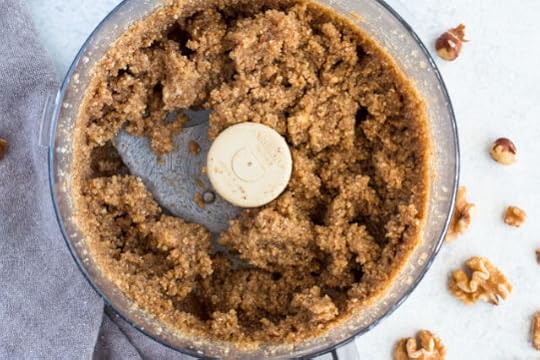
Preheat your oven to 325 degrees Fahrenheit. Add the walnuts, hazelnuts, coconut sugar and baking soda to a food processor. Process the nut mixture until a crumbly meal forms. You may need to stop the food processor one or two times to scrape the nuts off the side of the container. Add in the pieces of butter and continue pulsing until the crust mixture comes together in a ball.
Lightly grease a 9” tart tin. You can also place a circular piece of parchment on the bottom of the tin if you’d like. Press the crust mixture on the bottom and sides of the tart tin, working carefully to make sure all parts of the inside of the tin are covered in an even layer. Use a fork to place a handful of holes in the bottom of the pan. Place the crust in the oven to bake for 10-12 minutes.

Clean the food processor and add all of the filing ingredients to the food processor except the eggs. Combine the ingredients until well combined. Crack the eggs into the processor and process again until the mixture is smooth.
Pour the pumpkin mixture into the tart tin. Fill it just enough that a small amount of the crust is peeking out of the top, making sure not to overfill it. Carefully place the pie into the oven for 35-45 minutes, or until the center of the pie is just firm. If the outside crust is browning too quickly, you can use a pie crust shield. Allow the pie to fully cool. Once the pie has fully cooled, carefully pop it out of the tart pan.

While the pie is cooling, make the maple caramel by adding the caramel ingredients to a small saucepan over medium heat. Whisk occasionally. Once the mixture begins bubbling, reduce the heat to medium low. Continue heating the caramel for an additional minute or so until it reduces and thickens to the consistency of runny honey. Allow the caramel to cool slightly, then use a pastry brush to brush the top of the pumpkin pie with the caramel. Place the pie in the fridge for 30 minutes before slicing and serving. Top with a dollop of whipped cream.

Nutrition Information per serving (1/10 of pie):
Calories: 318
Total Carbs: 17 grams
Net Carbs: 13 grams
Fat: 26 grams
Protein: 7 grams


The post Ultimate Primal Pumpkin Pie appeared first on Mark's Daily Apple.



November 1, 2019
Weekly Link Love—Episode 53

Research of the Week
When postmenopausal, moderate energy restriction preserves far more muscle and bone than severe energy restriction.
Elevated levels of fat oxidation induced by a high-fat, low-carb diet do not impair 5k race performance.
Kids with ADHD and autism tend to have lower levels of vitamin B12 and higher levels of homocysteine.
There’s no direct archaeological evidence that Neanderthals did the classic Spanish cave art.
New Primal Blueprint Podcasts

Episode 385: The Primal Endurance Revolution: Host Brad Kearns and I chat about how Primal Endurance principles have changed the endurance game—and how they can revolutionize your health and performance.

Episode 386: Catharine Arnston: Host Elle Russ chats with Catharine Arnston, CEO and founder of ENERGYbits—a company making nutrient-dense algae tablets.
Each week, select Mark’s Daily Apple blog posts are prepared as Primal Blueprint Podcasts. Need to catch up on reading, but don’t have the time? Prefer to listen to articles while on the go? Check out the new blog post podcasts below, and subscribe to the Primal Blueprint Podcast here so you never miss an episode.
Media, Schmedia
Interesting Blog Posts
How antibiotic resistance may be spreading.
Could near infrared light help people with Alzheimer’s disease?
Social Notes
My new gym routine: less gym time, more playing.
Everything Else
At this point, what doesn’t the sun affect?
Turns out The Mouse and the Motorcycle was non-fiction.
Things I’m Up to and Interested In
Meat deal I think you should take advantage of: Butcher Box is offering a free turkey to everyone who places their first order.
I’m not surprised: Humans aren’t great at forecasting longterm existential catastrophes.
Big if true: Small study finds that vitamin D supplementation improves cognitive function in people with Alzheimer’s disease.
Big topic: Untangling the complex relationship between ketogenic dieting and gut bacteria.
Finding I haven’t seen advertised: The connection between ALS and statins.
Question I’m Asking
Recipe Corner
I love a good sheet pan recipe: sheet pan tandoori chicken.
3-2-1 smoked ribs.
Time Capsule
One year ago (Oct 26– Nov 1)
Urinary Urgency and Incontinence: Why It’s Not Just Age – What to do about having to go.
Dear Mark: Oxidative Priority Followup– Questions answered about fuel burning.
Comment of the Week
“Peter Attia has a great commentary on Game Changers:
https://peterattiamd.com/191027/”
– For those who want to hear more about the movie. Thanks, jeremy.

The post Weekly Link Love—Episode 53 appeared first on Mark's Daily Apple.



October 31, 2019
Dear Mark: Why “Game Changers” Isn’t Worth My Time and Sugar Addictions
 For today’s edition of Dear Mark, I’m answering a couple questions. The first one is a big one, one that multiple people have asked me across several different mediums: why don’t I do a full review of “Game Changers,” the vegan documentary on Netflix, or at least watch the film? I explain why I won’t watch it, why I don’t think it’s worth your time, and why I’ve already addressed it all before. Then, I answer why sugar is such a fixation for us and give some options for avoiding or mitigating it.
For today’s edition of Dear Mark, I’m answering a couple questions. The first one is a big one, one that multiple people have asked me across several different mediums: why don’t I do a full review of “Game Changers,” the vegan documentary on Netflix, or at least watch the film? I explain why I won’t watch it, why I don’t think it’s worth your time, and why I’ve already addressed it all before. Then, I answer why sugar is such a fixation for us and give some options for avoiding or mitigating it.
Let’s go:
Mark,
How come you dismissed the “Game Changers” documentary without watching it?
Because it’s not worth my time. The premise is simply preposterous.
Humans are omnivores. We have eaten meat for millions of years. And not just “eaten meat.”
We used animal femurs as bone marrow storage containers. We fought off massive African predators just to get at the meat and crack the bones for the goodness inside. We slurped brains. We smashed bones to bits and boiled them in animal skin bags to extract every last ounce of collagen and fat. We drove entire species to extinction in our lust for large portions of fatty animal meat.
Even after we were hunter-gatherers, the importance of animal products persisted. The biggest influx of humanity that provided a large portion of extant DNA across Europe and huge parts of Asia were livestock-driving nomadic herdsmen who ate cheese and yogurt (animal products—and not low-fat), drank blood, and hunted game. They farmed a little but relied so heavily on animal products for their calories that they had to borrow the agricultural words from the populations they displaced. To give you a taste of how important animal products were to them, their word for wealth was the same as the word for cattle.
What—that just goes away? Those millions of years of slurping and gnawing and atlatl-ing and spear throwing and stalking and weapons-craft and herding…don’t matter?
So, when a persuasive documentary comes out preaching about the evils of red meat (and let’s face it: it’s always about red meat) and the benefits of excising all meat from your diet in favor of plants, I laugh. I shrug. I smirk even.
Red meat consumption is down across the board. People listened to the “experts.” And guess what? Health got worse. Waists grew. Healthcare spending shot up. Diabetes spiked. Heart disease persisted (deaths decreased, thanks to better emergency care, but incidence is still there).
Does the documentary address all that? Does it mention the word “evolution”?
My time matters too much to me to waste it on the documentary. The arguments I’ve laid out in other responses to attacks on meat eating stand and, most likely, apply to the arguments in the documentary. Check these out for a few of my explorations of the “meat is bad” topic:
Does red meat give you colon cancer?
Read those, then get back to me. And I probably still won’t watch the documentary.
I’d rather spend my time:
Helping people who want the help.
Coming up with interesting new products that help people make better choices in the grocery store.
Playing Ultimate frisbee (and playing in general).
Writing about new topics or new developments of old topics.
I have yet to see a new argument from the plant-based crowd. I’ve heard the same things for years upon years. Nothing changes. “There’s nothing new under the sun.”
We have better things to do. Bigger fish to fry (in a gluten-free breading using low-PUFA oil kind of way).
How to conquer sugar addiction and is there a primal need to eat something sweet? Would Grok ever get the urge for something sweet?
Our relationship with sugar goes way back. In ancestral situations, sugar was rare. The urge to eat something sweet was so strong because it was so hard to get—a powerful urge was required to coerce the organism to do the work required to get the sugar. And in those situations, sugar was beneficial. An odd trove of honey represented a potent source of caloric energy, a way to replenish glycogen stores. Acute doses versus chronic overload. We have old cave paintings from 25000 years ago of honey hunters climbing trees to grab hives; that’s how much they prized it. Fruit, while not always plentiful or as oversized as today’s fruit, definitely existed—albeit to varying degrees depending on the climate and region. The farther you got from the equator, the scarcer sweet tastes became.
Even up to a few hundred years ago, when sugar was actually available, it remained a luxury item. It had to be imported, out of reach for most regular people.
Today, sugar is everywhere. We’re glutted with the stuff. We can’t escape it. And yet we still retain that ancestral mindset of sugar scarcity. Our bodies still crave it. Our physiological desires were molded in the context of low sugar availability. Introduce them to a sugar-replete environment and you get obesity, diabetes, heart disease, metabolic syndrome, and tooth decay.
I’m not sure if there’s a physiological need today to consume sugar. But there’s certainly a physiological desire to consume it. And really, the only way past it is to erect artificial barriers to sugar consumption.
Don’t keep sugar in the house.
Don’t use artificial sweeteners or even natural ones like stevia or monk fruit if they trigger the craving for real sugar.
Just say no. Sheer willpower may not hold out forever, but in those instances where you’re faced with an intense dose of sugar and you don’t want to eat it, don’t give in. You can do this.
Chronic doses of sugar are the real killer: those little peanut butter cups at the co-worker’s desk you grab every time you walk by, those peanut M&Ms at the secretary’s desk, those half donuts in the break room—they add up. They always add up. Acute doses of sugar probably aren’t a big deal for most reasonably healthy people. High quality dessert after a great dinner out? Birthday party and the host is a legit whiz in the kitchen? Try it.
Avoid anything you’re intolerant of or allergic to, of course. Avoid gluten whenever possible.
Whatever you do, don’t waste your acute doses of sugar on garbage. Don’t eat a Hostess donut. Don’t eat a half gallon of low-fat frozen yogurt from those places that charge you by the ounce.
Eat real ice cream made with great ingredients—just a child’s scoop. Don’t get the weird “ice cream” shake from the fast food joint.
Don’t get the microwaved lava cake from the chain restaurant. Share a portion of real panna cotta from the fancy restaurant.
That’s it for today, folks. If you have any other suggestions or comments or questions, throw them in down below.
Take care, everyone.
The post Dear Mark: Why “Game Changers” Isn’t Worth My Time and Sugar Addictions appeared first on Mark's Daily Apple.



October 30, 2019
Is Keto Insomnia a Common Problem?
 When I did my first earnest attempt at a keto diet a few years ago, one of the benefits I quickly noticed was improved wakefulness and energy during the day. I chalked this up to sleeping better on keto.
When I did my first earnest attempt at a keto diet a few years ago, one of the benefits I quickly noticed was improved wakefulness and energy during the day. I chalked this up to sleeping better on keto.
It turns out that I might have been one of the lucky ones. While plenty of people report improved sleep, a fair number also complain of insomnia, sleep disruptions (waking frequently during the night), and generally poor sleep once they go keto.
Can a keto diet really impact sleep quality? What might be the mechanism behind a correlation? And how does one work around any potential effect?
I’ve written a lot about sleep over the years, and I don’t intend to rehash what I’ve already written. Rather, I want to explore why a very-low-carb ketogenic diet specifically might impact sleep. I’ll link to some of my past posts at the bottom for those interested in improving overall sleep hygiene.
What is “Keto Insomnia?”
Insomnia disorder, as defined in the DSM-5, involves the following:
Difficulty falling asleep, difficulty staying asleep, and/or waking too early without being able to fall back to sleep
Symptoms occur at least three nights per week for at least three months
Sleep problems are not explained by other illness, medication, and so on
Distress and/or impaired ability to function in daily life
Acute insomnia is similar, but it’s short-term and might be attributable to a specific trigger, such as a stressful event, major life change, or travel.
People who complain about “keto insomnia” seem to mean one of two things:
Sleep disruptions that occur during the transition phase—the days or weeks immediately after starting keto (acute)
Sleep issues that start after being keto for a few months or longer (might be acute or chronic)
It can be hard to know whether the latter are actually related to keto at all. However, if diet is the only obvious change these folks have made, keto seemingly takes the rap.
Why Might Keto Mess with Your Sleep?
On possible clue is this oft-cited study in which participants experienced decreased REM and increased slow-wave sleep when following a keto diet. Decreased REM sleep can contribute to the subjective experience of insomnia. However, total sleep was not impacted. This study was also small, involving 14 participants who followed a keto diet for just two days.
Other than that, however, there’s not much to go on. A couple studies found no change in sleep quality among healthy adults following a keto diet, and a handful of others reported improved sleep quality (in epileptic children and obese adolescents).
Moreover, the team at Virta Health recently released their findings after one year of treating diabetic and prediabetic patients with keto diet interventions. Their patients enjoyed significant improvements in sleep quality and daily functioning compared to baseline and compared to individuals who didn’t go keto.
All together, the research so far suggests that when it comes to sleep, keto is neutral-to-positive for healthy adults and beneficial for individuals struggling with certain health conditions. Of course, the data are still quite sparse.
A somewhat larger, but still limited, body of research has looked more generally at how the macronutrient composition of one’s diet affects sleep. To be blunt, the results of these studies are all over the map. There’s tremendous variation from study to study in terms of how diets were constructed or measured, food timing, other relevant dietary factors such as total calorie intake and fiber content, as well as what aspects of sleep were assessed and how. Depending on which study you’re reading, consuming fat, protein, or carbohydrates might seem to help, hurt, or have no effect on sleep.
In short, there’s no compelling scientific explanation for when or why keto would harm your sleep. I know this is no comfort to those of you who are experiencing sleep disruptions now, however. Let’s turn to some things you can try if you’re not in the camp of good sleep while keto.
Possible Solutions
Despite the dearth of research, it’s possible to make some reasonable guesses about what might be causing your sleep issues. Of course, before trying any of the supplement suggestions below, consult your doctor. Likewise, get help if your sleep is so poor that you are having trouble functioning.
First, the obvious: basic sleep hygiene. These are the things I harp on all the time, like avoiding blue light at night and honoring a consistent bedtime. Sure, you probably didn’t change any of these when you went keto. However, it might be that something about keto eating—like getting less tryptophan to your brain (I’ll explain in a minute)—is making you more sensitive to poor sleep habits. Refer to my other sleep posts linked below for more details.
Check your electrolytes. Especially if you’re new to keto, electrolytes are the most likely culprit for sleep issues. You want to aim for the following daily:
3-5 grams of sodium on top of what you get from food
3-5 grams of potassium
500 mg of magnesium
Most keto newbies drastically underestimate how important electrolytes are, not just for sleep but for energy, workout performance, and avoiding the keto flu. Check out this post for more details.
For sleep issues, start with magnesium. Make sure you’re including plenty of magnesium-rich foods such as leafy greens, dark chocolate, and hemp seeds in your diet. You can also supplement with magnesium—the glycinate form is preferred for sleep—starting with 100-400 mg as needed.
Also consider adding a mug of warm bone broth to your evening routine. Besides being soothing, it’s a great way to get sodium and the amino acid glycine. Glycine is the most abundant amino acid in collagen. Supplementing with 3 grams of glycine before bed has been shown to improve sleep.
You can also supplement collagen for its many benefits. Aim for at least 10 grams at night. Maybe whip up a batch of Chocolate Collagen Pudding (sweetened with stevia or monk fruit for keto).
Make sure you’re neither too hungry nor too full at bedtime. As you adjust to your new way of eating, try to avoid extremes of hunger in the evening. If you’re practicing intermittent fasting, make sure your fasting window isn’t leaving you stuffed or famished at when it’s time to hit the hay.
Dial back the caffeine. Is it possible you’ve been a little too enthusiastic about fatty coffee since going keto?
Get your stress in check. We all know that stress is a sleep killer, and I see stress running high in the keto community. Micromanaging macros, worrying about which foods are and are not “allowed,” trying to do too much too soon—keto folks can really get themselves worked up. If this sounds familiar, you need to take a step back and work on stress reduction.
Try adding a small amount of high-glycemic carbs to your dinner. Wait, what? Am I really telling you to eat more carbs on keto? Yes, for a good reason.
As you probably know, melatonin is the hormone primarily responsible for regulating your sleep-wake cycle. The amino acid tryptophan is a precursor of melatonin. In the brain, tryptophan converts to 5-HTP, then serotonin, then melatonin. To get into the brain, tryptophan relies on protein transporters, which also carry other amino acids across the blood-brain barrier. When there is too much traffic—that is, too many other amino acids trying to use the protein transporters—not enough tryptophan can get across.
Insulin shuttles those competing amino acids into muscles, leaving the roads clear for tryptophan so to speak. By adding some high-GI carbs to your last meal of the day, you bump up insulin and facilitate this process.
Now, I wouldn’t recommend this as your first option if you are brand new to keto. However, if you’re one of those people who is suddenly struggling with sleep after being keto for a while, this is worth trying. Michael Rutherford, NTP, Primal Health Coach, and moderator of our Keto Reset Facebook group says his clients have had good results adding ~20 grams of carbs to their last meal of the day. Potatoes or sweet potatoes are good choices.
If you just can’t bring yourself to eat more carbs, you can also supplement with tryptophan. A dose of 250-500 mg is a good place to start, increasing as needed. Chris Masterjohn recommends taking tryptophan on an empty stomach and as far as possible from other sources of protein.
Another possible workaround is to supplement with 5-HTP, which is a common ingredient in sleep aids. Rutherford advises his clients to start with 100 mg of 5-HTP taken 30-60 minutes before bed. Be cautious with this supplement if you have depression or anxiety.
Skip the middlemen and supplement melatonin. Melatonin supplementation is somewhat controversial. It’s not my first choice—I’d rather you start by addressing sleep hygiene and tweaking your diet—but I’m not opposed to supplementing as needed.
Doses as low as 0.5 mg can be effective, although as much as 5 mg is generally regarded as safe. I recommend starting at the bottom end, since lower doses are closer to normal physiological levels. Take melatonin at least an hour after eating your last food of the day.
Get your thyroid and cortisol levels checked. If none of your self-experimentation works, or if you’re having other signs of thyroid imbalance, get your thyroid function and cortisol levels checked. While I don’t believe keto is inherently bad for thyroid or adrenal health, it’s certainly worth a trip to your doc.
What’s your experience? Are you sleeping like a baby on low-carb/keto—or not? Have you found any solutions other than those suggested here? Comment below, and have a great week, everyone.
______________
More sleep tips from Mark’s Daily Apple
7 Ways You Might Be Inadvertently Sabotaging a Good Night’s Sleep
10 Natural Sleep Aids: What Works and Why
How to Manufacture the Best Night of Sleep in Your Life
______________

References
Herrera CP, Smith K, Atkinson F, Ruell P, Chow CM, O’Connor H, Brand-Miller J. High-glycaemic index and -glycaemic load meals increase the availability of tryptophan in healthy volunteers. Br J Nutr. 2011 Jun;105(11):1601-6.
Levenson JC, Kay DB, Buysse DJ. The pathophysiology of insomnia. Chest. 2015;147(4):1179–1192.
Peuhkuri K, Sihvola N, Korpela R. Diet promotes sleep duration and quality. Nutr Res. 2012 May;32(5):309-19.
Riemann D, Spiegelhalder K, Nissen C, Hirscher V, Baglioni C, Feige B. REM sleep instability–a new pathway for insomnia? Pharmacopsychiatry. 2012 Jul;45(5):167-76.
Silber BY, Schmitt JA. Effects of tryptophan loading on human cognition, mood, and sleep. Neurosci Biobehav Rev. 2010 Mar;34(3):387-407.
St-Onge MP, Mikic A, Pietrolungo CE. Effects of Diet on Sleep Quality. Adv Nutr. 2016 Sep 15;7(5):938-49.
The post Is Keto Insomnia a Common Problem? appeared first on Mark's Daily Apple.



Mark Sisson's Blog
- Mark Sisson's profile
- 199 followers



